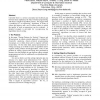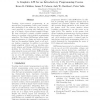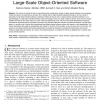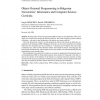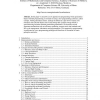SIGCSE
2002
ACM
14 years 4 months ago
2002
ACM
Currently there is a serious conceptual and technical gap between ideas emphasized in object-oriented programming and ideas as taught in algorithms courses. We suggest both a para...
CORR
1998
Springer
14 years 4 months ago
1998
Springer
Teaching object-oriented programming in an introductory programming course poses considerable challenges to the instructor. An often advocated approach to meeting this challenge i...
IEE
2002
14 years 4 months ago
2002
Abstract. This paper describes an approach to providing object persistence in object-oriented programming languages without modifying the run-time system or the language itself. By...
TSE
2008
14 years 4 months ago
2008
The metrics formulated to date for characterizing the modularization quality of object-oriented software have considered module and class to be synonymous concepts. But, a typical ...
IIE
2008
14 years 4 months ago
2008
Teaching object-oriented programming (OOP) is related to many difficulties. There is no single view on their causes among the university teachers. The results of applying various m...
CORR
2008
Springer
14 years 4 months ago
2008
Springer
In this paper we describe a new approach to programming which generalizes object-oriented programming. It is based on using a new programming construct, called concept, which gener...
DOCENG
2008
ACM
14 years 6 months ago
2008
ACM
Semantic web researchers tend to assume that XML Schema and OWL-S are the correct means for representing the types, structure, and semantics of XML data used for documents and int...
ECOOP
1987
Springer
14 years 7 months ago
1987
Springer
``Object-Oriented Programming'' and ``Data Abstraction'' have become very common terms. Unfortunately, few people agree on what they mean. I will offer informa...
REX
1990
14 years 8 months ago
1990
Data Types William R. Cook Hewlett-Packard Laboratories 1501 Page Mill Road, Palo Alto, CA, 94303-0969, USA Abstract: This tutorial collects and elaborates arguments for distinguis...
OOPSLA
1990
Springer
14 years 8 months ago
1990
Springer
The paper presents a discussion and a specification of an exception handling system dedicated to object-oriented programming. We show how a full object-oriented representation of ...
